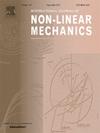高斯和泊松联合白噪声激励下高维非线性系统的概率解
IF 2.8
3区 工程技术
Q2 MECHANICS
International Journal of Non-Linear Mechanics
Pub Date : 2025-06-11
DOI:10.1016/j.ijnonlinmec.2025.105186
引用次数: 0
摘要
确定高斯白噪声和泊松白噪声联合激励下非线性系统的概率密度函数解在随机动力学中具有重要意义。然而,这个任务在高维系统中变得难以计算。为了解决这一挑战,本研究采用了先前开发的用于分析高斯白噪声下系统响应的降维方法。本文将该方法推广到确定高斯白噪声和泊松白噪声联合激励下非线性系统的平稳响应。该方法利用广义Fokker-Planck-Kolmogorov (GFPK)方程来描述系统响应PDF的演化。通过对级数型GFPK方程中无关状态变量的积分,得到一维积分-微分方程。然后,对该降维GFPK方程引入等效漂移系数,其等效形式仍为一维正演GFPK方程。最后,采用四阶有限差分法(FDM)对该降维GFPK方程进行求解,得到了该方程的平稳速度响应。以六自由度耦合Duffing-van der Pol系统和速度项为非线性项的八自由度系统为例验证了该方法的有效性。数值计算结果表明,该方法与蒙特卡罗模拟(MCS)结果吻合较好。此外,还讨论了泊松噪声的非零平均脉冲幅值等参数。本文章由计算机程序翻译,如有差异,请以英文原文为准。
Probabilistic solution of high-dimensional nonlinear systems excited by combined Gaussian and Poisson white noise
Determining the probability density function (PDF) solution for nonlinear systems excited to combined Gaussian and Poisson white noise is of great significance in stochastic dynamics. However, this task becomes computationally intractable for high-dimensional systems. To address this challenge, this study employs a dimension-reduction method previously developed for analyzing system responses under Gaussian white noise. Here, the method is extended to determine the stationary responses of nonlinear systems under combined Gaussian and Poisson white noise excitations. The proposed approach utilizes the generalized Fokker-Planck-Kolmogorov (GFPK) equation to describe the evolution of the system response PDF. By integrating the unconcerned state variables in the series-form GFPK equation, a one-dimensional integro-differential equation is obtained. Then, equivalent drift coefficients are introduced for this dimension-reduced GFPK equation, whose equivalent form is still a one-dimensional forward GFPK equation. Finally, the fourth-order finite difference method (FDM) is applied to solve this dimension-reduced GFPK equation, and its stationary velocity responses are obtained. A six degree-of-freedom (DOF) coupled Duffing-van der Pol system and an 8-DOF system with nonlinear terms in the velocities are demonstrated to validate the proposed approach. Numerical results show that the proposed approach is in good agreement with the Monte Carlo simulation (MCS) results. In addition, some parameters, such as nonzero mean impulse amplitudes of the Poisson noise, are discussed in the examples.
求助全文
通过发布文献求助,成功后即可免费获取论文全文。
去求助
来源期刊
CiteScore
5.50
自引率
9.40%
发文量
192
审稿时长
67 days
期刊介绍:
The International Journal of Non-Linear Mechanics provides a specific medium for dissemination of high-quality research results in the various areas of theoretical, applied, and experimental mechanics of solids, fluids, structures, and systems where the phenomena are inherently non-linear.
The journal brings together original results in non-linear problems in elasticity, plasticity, dynamics, vibrations, wave-propagation, rheology, fluid-structure interaction systems, stability, biomechanics, micro- and nano-structures, materials, metamaterials, and in other diverse areas.
Papers may be analytical, computational or experimental in nature. Treatments of non-linear differential equations wherein solutions and properties of solutions are emphasized but physical aspects are not adequately relevant, will not be considered for possible publication. Both deterministic and stochastic approaches are fostered. Contributions pertaining to both established and emerging fields are encouraged.

 求助内容:
求助内容: 应助结果提醒方式:
应助结果提醒方式:


